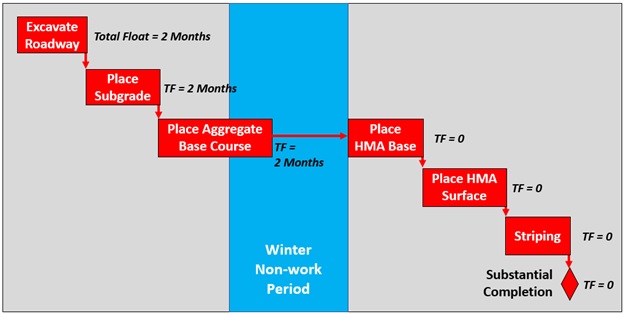Construction Delay Analysis – Principle No. 2 of 5
Delay Analysis Principle No. 2:
Not every delay to the critical path will delay the project.
As introduced in the Delay Analysis Principle No. 1 blog posting, “only delays to the project’s critical path will delay the project.” However, the converse is not true – “not every delay to the critical path delays the project.”
For a delay to the critical path to not delay the project, some critical path activities must have positive total float values. The most common reason for a critical path activity to have positive total float value is that it has been assigned a “work calendar” containing a non-work period. The classic example is a temperature-sensitive work item, like the placement of concrete and hot mix asphalt (HMA). These work activities would be assigned to a “work calendar” that shows the winter as a non-work period.
Consider the following graphical depiction of the critical path of a roadway project. Note that the project’s critical path consists of excavation, subgrade, and base course work that is followed by the placement of HMA, the striping of the roadway, and substantial completion.

Note that the placement of the aggregate base course is planned to finish during the winter. However, the contractor is unable to place the HMA until the asphalt plants open in the spring. The time between the placement of asphalt aggregate base and the start of HMA aggregate base is float, which in this example is two months.
Some argue that the excavation, subgrade, and base course work are not critical path activities because they have positive float. This argument ignores the fact that the essential characteristics of the “critical path,” which are a “. . .series of activities that determines a project’s completion. . .” and that the “. . . duration of the activities on the critical path controls the duration of the entire project.” In this example, the 2 months of float are part of the critical path, because it is included in the determination or calculation of the project’s completion date.
Because the excavation, subgrade, and base course activities have 2 months of float, they can be delayed up to two months, consuming their available float, before the start of the HMA base work and the project is delayed.
For more on this or any other topic, please call me at 215-814-6400 or email me at mark.nagata@traunerconsulting.com.

